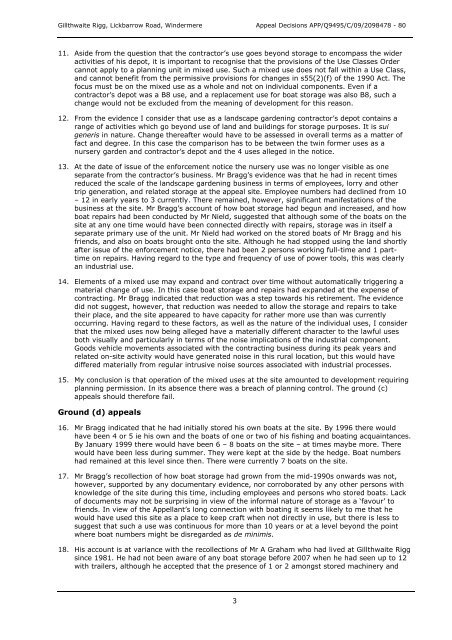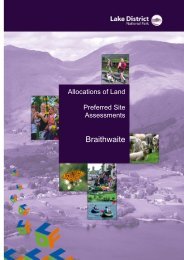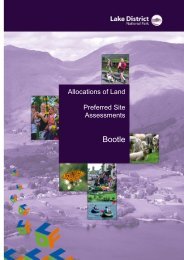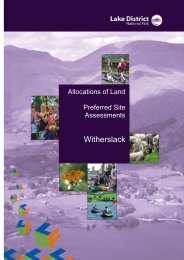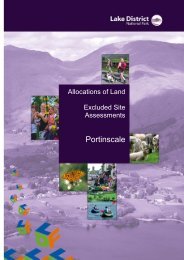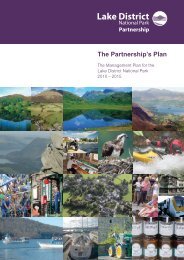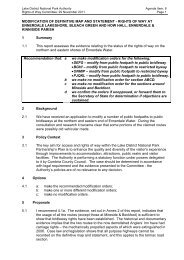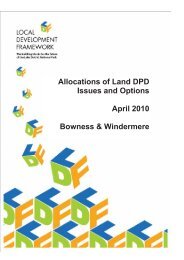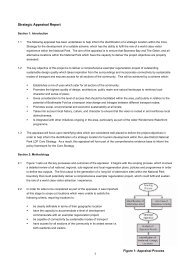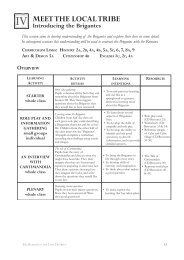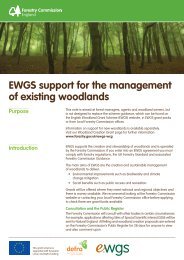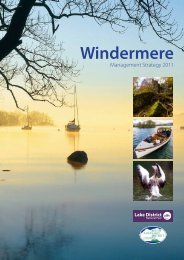Appeal Decision Letter October 2009 (PDF) - Lake District National ...
Appeal Decision Letter October 2009 (PDF) - Lake District National ...
Appeal Decision Letter October 2009 (PDF) - Lake District National ...
Create successful ePaper yourself
Turn your PDF publications into a flip-book with our unique Google optimized e-Paper software.
Gillthwaite Rigg, Lickbarrow Road, Windermere <strong>Appeal</strong> <strong>Decision</strong>s APP/Q9495/C/09/2098478 - 80<br />
11. Aside from the question that the contractor’s use goes beyond storage to encompass the wider<br />
activities of his depot, it is important to recognise that the provisions of the Use Classes Order<br />
cannot apply to a planning unit in mixed use. Such a mixed use does not fall within a Use Class,<br />
and cannot benefit from the permissive provisions for changes in s55(2)(f) of the 1990 Act. The<br />
focus must be on the mixed use as a whole and not on individual components. Even if a<br />
contractor’s depot was a B8 use, and a replacement use for boat storage was also B8, such a<br />
change would not be excluded from the meaning of development for this reason.<br />
12. From the evidence I consider that use as a landscape gardening contractor’s depot contains a<br />
range of activities which go beyond use of land and buildings for storage purposes. It is sui<br />
generis in nature. Change thereafter would have to be assessed in overall terms as a matter of<br />
fact and degree. In this case the comparison has to be between the twin former uses as a<br />
nursery garden and contractor’s depot and the 4 uses alleged in the notice.<br />
13. At the date of issue of the enforcement notice the nursery use was no longer visible as one<br />
separate from the contractor’s business. Mr Bragg’s evidence was that he had in recent times<br />
reduced the scale of the landscape gardening business in terms of employees, lorry and other<br />
trip generation, and related storage at the appeal site. Employee numbers had declined from 10<br />
– 12 in early years to 3 currently. There remained, however, significant manifestations of the<br />
business at the site. Mr Bragg’s account of how boat storage had begun and increased, and how<br />
boat repairs had been conducted by Mr Nield, suggested that although some of the boats on the<br />
site at any one time would have been connected directly with repairs, storage was in itself a<br />
separate primary use of the unit. Mr Nield had worked on the stored boats of Mr Bragg and his<br />
friends, and also on boats brought onto the site. Although he had stopped using the land shortly<br />
after issue of the enforcement notice, there had been 2 persons working full-time and 1 parttime<br />
on repairs. Having regard to the type and frequency of use of power tools, this was clearly<br />
an industrial use.<br />
14. Elements of a mixed use may expand and contract over time without automatically triggering a<br />
material change of use. In this case boat storage and repairs had expanded at the expense of<br />
contracting. Mr Bragg indicated that reduction was a step towards his retirement. The evidence<br />
did not suggest, however, that reduction was needed to allow the storage and repairs to take<br />
their place, and the site appeared to have capacity for rather more use than was currently<br />
occurring. Having regard to these factors, as well as the nature of the individual uses, I consider<br />
that the mixed uses now being alleged have a materially different character to the lawful uses<br />
both visually and particularly in terms of the noise implications of the industrial component.<br />
Goods vehicle movements associated with the contracting business during its peak years and<br />
related on-site activity would have generated noise in this rural location, but this would have<br />
differed materially from regular intrusive noise sources associated with industrial processes.<br />
15. My conclusion is that operation of the mixed uses at the site amounted to development requiring<br />
planning permission. In its absence there was a breach of planning control. The ground (c)<br />
appeals should therefore fail.<br />
Ground (d) appeals<br />
16. Mr Bragg indicated that he had initially stored his own boats at the site. By 1996 there would<br />
have been 4 or 5 ie his own and the boats of one or two of his fishing and boating acquaintances.<br />
By January 1999 there would have been 6 – 8 boats on the site – at times maybe more. There<br />
would have been less during summer. They were kept at the side by the hedge. Boat numbers<br />
had remained at this level since then. There were currently 7 boats on the site.<br />
17. Mr Bragg’s recollection of how boat storage had grown from the mid-1990s onwards was not,<br />
however, supported by any documentary evidence, nor corroborated by any other persons with<br />
knowledge of the site during this time, including employees and persons who stored boats. Lack<br />
of documents may not be surprising in view of the informal nature of storage as a ‘favour’ to<br />
friends. In view of the Appellant’s long connection with boating it seems likely to me that he<br />
would have used this site as a place to keep craft when not directly in use, but there is less to<br />
suggest that such a use was continuous for more than 10 years or at a level beyond the point<br />
where boat numbers might be disregarded as de minimis.<br />
18. His account is at variance with the recollections of Mr A Graham who had lived at Gillthwaite Rigg<br />
since 1981. He had not been aware of any boat storage before 2007 when he had seen up to 12<br />
with trailers, although he accepted that the presence of 1 or 2 amongst stored machinery and<br />
3


